Connections with culture

The QAGOMA Learning program accompanying ‘No 1 Neighbour: Art in Papua New Guinea 1966-2016’ focusses on the role art can play in building bridges to cultural heritage and history.
A pupil-free day in mid-October enabled 47 Papua New Guinean students from six schools in South East Queensland to travel to the Gallery to explore the exhibition and take part in workshops with artists in the exhibition.
EXPLORE THE EXHIBITION INSTALLATION FURTHER
DELVE DEEPER INTO THE ART OF PAPUA NEW GUINEA
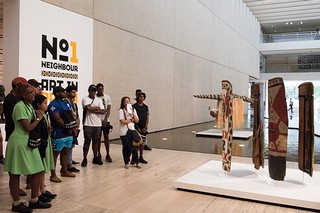
As they gathered under the broad ceiling of the Kwoma Koromb, Mekeo artist Julia Mage’au Gray marked out five tatu (tattoo) designs students would learn about and then choose from to mark a textile lap-lap describing their personal connection to place and people.
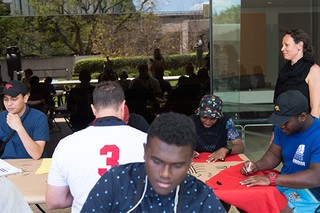
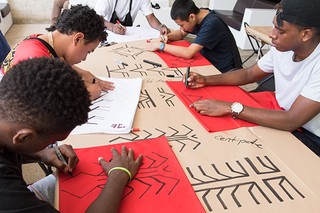
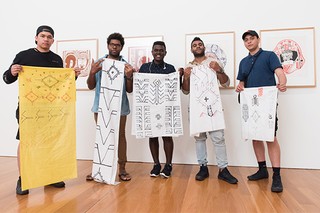
Later, songs of the Tolai guanatuna of East New Britain featured in the exhibition’s a Bit na Ta installation, would resonate through the Lecture Theatre as students, led by George Telek, Gideon Kakabin and David Bridie stepped out traditional dance steps.
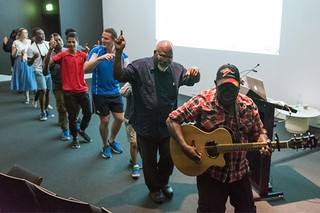
“This engagement with culture, art and practice is vital. I have no doubt that the real outcomes of the students’ interactions with Julia Mage’au Gray and with us a Bit na Ta mob (David Bridie, George Telek and Gideon Kakabin) may not surface for a few years yet when the importance of their heritage and custom seeps in in their thinking and practice.The unique attribute all these students share is their culture, the language (tok ples) and songs and ways that their ancestors have passed down to them.
These students are some of the more privileged PNG youth, so it is utterly vital that they take this on board as they will be part of the future leaders and their country will need them!” David Bridie
Developed especially to accompany the ‘No 1 Neighbour’ exhibition, the workshop actively engaged students in explorations of the rich history and cultural diversity of Papua New Guinea as well as ideas of identity and its markers.
“It was a day for the students to connect with each other, as well as friends from home and celebrate their heritage.”
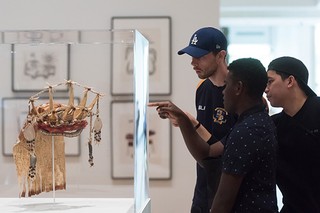
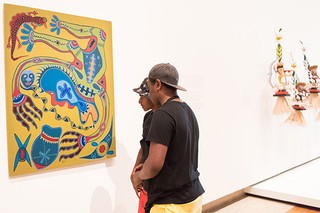

Laughter abounded as students watched video interviews Julia Mage’au Gray had filmed with them as part of her Pasifika Youth Workshop, exploring cultural markers and pride.
On Monday 17 October 2016, young people from PNG who are schooling in Brisbane were hosted by QAGOMA Learning. During the workshop, students were able to connect with each other, and reflect on and celebrate their PNG heritage. The video interviews, facilitated by Julia Mage’au Gray, are part of the Pasifika Youth Workshops exploring identity.
Selfies with George Telek and works in the exhibition were recorded on many a phone.

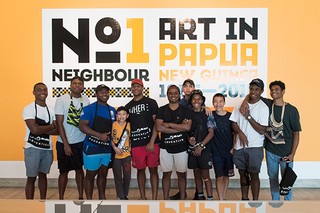
In the students’ words:
“My highlight of the workshop today was actually working with the artists, and listening, watching and learning what they do”.
“I learnt that I have a long and proud history involving culture and traditions that have been passed on for generations”.
“I learnt how unique PNG is and how proud I am to be PNG”.
The QAGOMA Learning Collection Resource provides opportunities to learn more about selected artworks in the exhibition.
Story co-authored by Ruth McDougall and QAGOMA Learning team
http://blog.qagoma.qld.gov.au/wp-content/media/BLOG-No-1-Neighbour-book-for-blog.jpg
BUY THE PUBLICATION IN-STORE AND ONLINE
Our richly illustrated hardcover publication accompanies the exhibition, with contributions from Ruth McDougall, Tolai artist and historian Gideon Kakabin, Manus Island musician John Faunt, and commentators Kiri Chan and Ruth Choulai, as well as numerous artist interviews.
‘No.1 Neighbour’ is supported by the Gordon Darling Foundation and through the Australian Government through the Australian Cultural Diplomacy Grants Program of the Department of Foreign Affairs and Trade.
Produced in association with ‘No.1 Neighbour: Art in Papua New Guinea 1966-2016′ | Queensland Art Gallery | Until 29 Jan 2017 | Free

